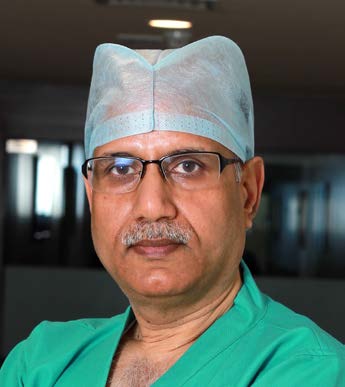Aesthetic Plastic Surgeon
RHINOPLASTY

Dr Lokesh Kumar Senior Director & HOD BLK Max Super specialty Hospital New Delhi 30 years in practice
Having successfully treated numerous patients, Dr Lokesh Kumar is a leading name in the field of plastic and cosmetic surgeries. He has been widely acknowledged for his versatile and patient-centric approach. He is a MBBS, MS (General Surgery), MCh (Plastic Surgery), and has a Fellowship from the International College of Surgeons Chicago USA (Plastic Surgery). He has also previously been a senior consultant with Indraprastha Apollo Hospital, New Delhi; consultant with Majeedia Hospital, New Delhi; and associate consultant of Holy Family Hospital, New Delhi.
Know more from Dr Kumar about Rhinoplasty:
Who is a good candidate for Rhinoplasty? What is the type of patient you typically see for this procedure?
A good candidate for rhinoplasty is someone who is mature enough to understand intricacies of this complex operation, is clear in his/her mind what he/ she desires in terms of changes in nasal shape, psychologically stable and realistic in his/her demand. We usually see patients in the age group of 20-50 years, both male and female in equal numbers. It is important to filter out all the candidates who are seeking rhinoplasty for ulterior motives and those who have psychological issues. If in doubt, a psychiatry consultation is of great help.
How can best results be derived from this treatment? Tell us about the surgical technique adopted by you?
The foundation of a successful outcome of a rhinoplasty operation is in the preoperative consultation. A detailed interview of the patient on multiple occasions is the key. This gives an opportunity to the surgeon to get into the patient’s mind about his/her awareness of the problem, and to identify any psychological undertones in the patient’s personality. Analysis of the deformity gives an idea about the surgical technique to be adopted. About 70 per cent of patients in India have a weak framework and need structural techniques to build it. Consequently, they need extra nasal donor site for procuring a cartilage graft. And so they have to be counseled for the same. Rhinoplasty is not done only for cosmetic reasons, and many a times, there are functional issues to be resolved. Preoperative Cone Beam CT scan is of immense help in diagnosing functional issues and should be ordered in all such cases. A perfect rhinoplasty operation is the one which aims to address and correct both these issues simultaneously. A piecemeal correction of the septum first, as advocated by many colleagues makes things difficult for subsequent cosmetic correction.
Open rhinoplasty gives best exposure and an opportunity for appropriate anatomical correction. The inverted ‘V’ incision in the mid columellar region gives an imperceptible scar. Incision is carefully developed avoiding any injury to the underlying medial crus. The dissection plane is kept close to the underlying cartilages till the key stone area. Further, undermining is carried out in the subperiosteal plane over nasal bones. Midline sharp dissection in between the medial crura exposes distal end of septum, which is exposed by lifting the mucoperichondrial flaps on both sides. This completes the exposure and further actions will depend on the requirements of a particular case. Usual sequence of events to follow are septal correction, correction of dorsum and tip plasty in that order. If the nose is to be augmented, we usually select extra nasal donor site such as a rib cartilage and the graft is harvested right in the beginning of the operation allowing time for any warping to reveal before it is ready for use.
What is the recovery time for a rhinoplasty surgery and what is the posttreatment care involved?
The patient is discharged from the hospital the next day after the surgery and is called for suture or dressing removal after eight days. He is allowed to undertake his routine work after this. The typical recovery time for a standard rhinoplasty operation is three to four weeks. However, a final outcome is only evident at the end of three months or more because that much time is needed for edema to subside. Postoperative care involves regular cleaning of the nostrils and to not allow the crusts to accumulate as they may harbor infection.
Any contraindications involved that one should be aware off? Also, is there anything the patient must not do after the procedure?
The biggest contraindication for rhinoplasty is underlying psychological disorder, which is sometimes missed even by experts. Rhinoplasty is also avoided in underage patients and usually we follow 18 years as the cutoff age for accepting a patient for this procedure. One exception could be though if a patient is suffering because of the severe deviation of septum causing breathing issues.
In the post-operative period, the patient should be careful not to traumatise the nose. He/she should avoid facial massage for three to four weeks post the surgery.
Which do you consider as most challenging as well as successful case studies for this treatment?
Rhinoplasty operation in itself is a challenging job. There are various kind of noses that require different set of strategies for a successful outcome. In India particularly, a variety of noses ranging from Caucasian type in extreme north, oriental type in north-east, and a mixture of deformities in rest of India make this operation both challenging and interesting. A typical Indian nose has thick soft tissue envelop that is covers weak underlying skeleton. These type of cases are most challenging to a rhinoplasty surgeon as he not only has to strengthen the weak skeleton but also has to thin the underlying soft tissue within the safe limits.
Most of the secondary and tertiary operations are quite challenging. The first time is the best time for this operation. But if for some reason, the first surgeon does not get the desired result, subsequent operations become quite challenging. These secondary corrections are technically demanding and rarely achieve what possibly could have been achieved the first time. This is one surgery where even qualified surgeons can mess up if they are not specifically trained in this operation. The patient should do their homework well before choosing his/her surgeon for this operation.

Picture: For representational purpose